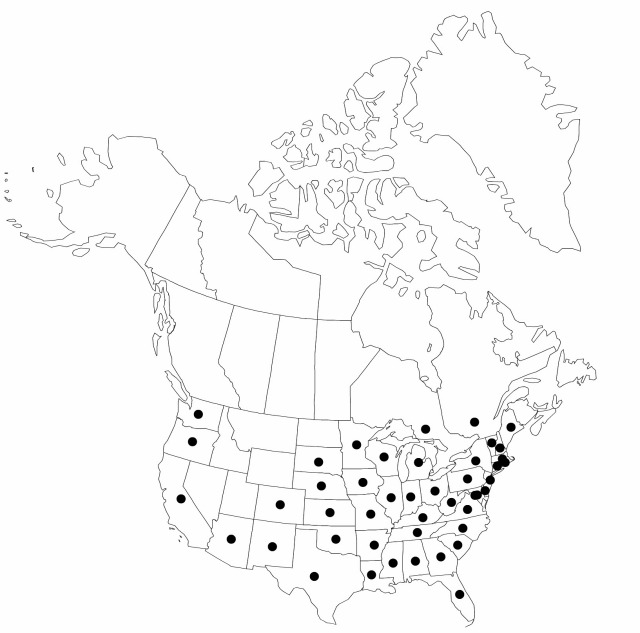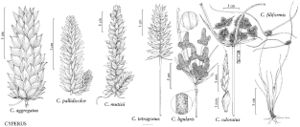Difference between revisions of "Cyperus odoratus"
Sp. Pl. 1: 46. 1753.
FNA>Volume Importer |
(No difference)
|
Revision as of 01:44, 27 July 2019
Herbs, annual (or short-lived perennial). Culms trigonous, (4–)10–50(–130) cm × (0.5–)1–4 mm. Leaves flanged V- or inversely W-shaped, 5–30(–60) cm × 4–12 mm. Inflorescences: spikes 1–5(–12), loosely to densely cylindric, ovoid, or ± pyramidal, 10–20(–40) × (8–)10–30(–35) mm; rays (0–2)6–9(–12), 2–8(–13) cm; if rays absent, infloresence a single dense, capitate cluster of closely imbricate spikes; bracts (4–)5–8(–10), horizontal to ascending at 30–60°, (3–)10–25(–55) cm × 1–14 mm; rachilla hyaline or thickened bronze, carmine, or yellowish, wings clasping achene. Spikelets (10–)20–60(–100), linear-oblong to narrowly linear, cylindric to slightly flattened (when scale tips spreading), (5–)8–15(–38) × 0.8–1.3(–1.9) mm; floral scales (4–)8–12–(30), medially green, laterally reddish to stramineous to shiny brown or beige, medially 2–5-ribbed, laterally 1–3-ribbed, ovate to elliptic, (2–)2.2–2.8(–3.2) × (1.2–)1.4–1.6(–1.8) mm, apex entire or emarginate with mucro to 0.3 mm. Flowers: anthers (0.2–)0.3–0.4(–0.7) mm; styles 0.4–0.7(–1) mm; stigmas (1–)1.5–3 mm. Achenes brown, reddish brown, or black, stipitate, narrowly ellipsoid to oblong (rarely obovoid-oblong), (1–)1.2–1.5(–1.9) × 0.5–0.6(–0.75) mm, stipe 0.1–0.2 mm, apex acute to barely obtuse, surfaces finely papillose.
Phenology: Fruiting summer–early fall.
Habitat: Emergent shorelines, disturbed, muddy places, fresh or slightly brackish marshes
Elevation: 0–1500 m
Distribution

Ont., Que., Ala., Ariz., Ark., Calif., Colo., Conn., Del., D.C., Fla., Ga., Ill., Ind., Iowa, Kans., Ky., La., Maine, Md., Mass., Mich., Minn., Miss., Mo., Nebr., N.H., N.J., N.Mex., N.Y., N.C., Ohio, Okla., Oreg., Pa., R.I., S.C., S.Dak., Tenn., Tex., Vt., Va., Wash., W.Va., Wis., Central America, South America, Asia, Africa, Pacific Islands (Hawaii), Australia.
Discussion
As circumscribed here, Cyperus odoratus is easily identified by its cylindric to subcylindric spikelets in which the corky rachilla of the mature spikelet disarticulates at the base of each scale. The mature spikelet breaks into segments each consisting of a scale and an internode of the rachilla clasping the achene with its corky wings. Cyperus odoratus is an exceedingly variable pantropical and warm-temperate species. Numerous segregates have been named, some of which may deserve recognition when the species is studied in detail worldwide.
Selected References
None.
